The team at Sasaki takes us through 3 recent projects that demonstrate the positive outcomes of good design.
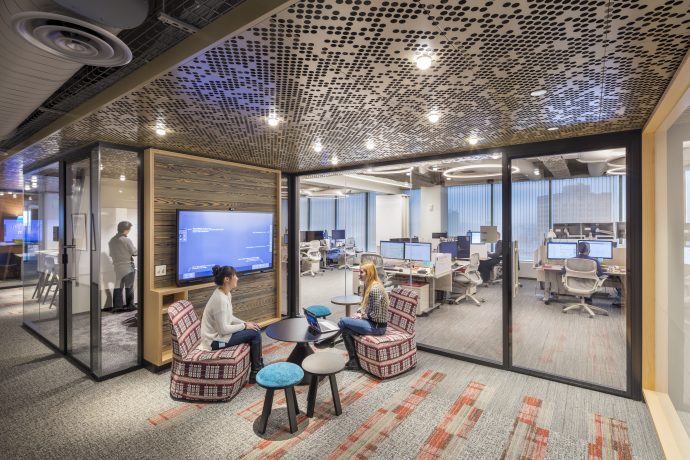
Physical place-branding has always been important, but at this moment, twenty years into the internet-generated digital age, it matters more than ever. Today, ideas, businesses, and relationships could live solely online, operating in a digital capacity only, but that’s not the direction most companies are headed. We are seeing the swing toward remote work of the first half of the decade boomerang back toward in-person collaboration at many workplaces. Leaders are realizing the irreplicable value of face-to-face collaboration and the resulting boost to their business’s output and success.
Many companies are doubling down on creating environments that invite employees to come together, whether their people work onsite every day or need to connect in-person between jaunts on the road. There are good and bad ways to go about this: light-touch furniture and decorative investments can give an office a much-needed face-lift, but it won’t go so far as to provoke a change in behavior or elicit a transformation in operations and work style; it just makes space pretty. Nothing beats the deeper investment in customizing the organization of program and designing to cater to the specific needs of a given business and workforce population. Move beyond the pretty and get to creating an efficient machine, because to get office-design wrong or right, has far-reaching implications. Good and intentional office design improves business development, recruitment, productivity, and, retention—vital inputs to the success of any company.
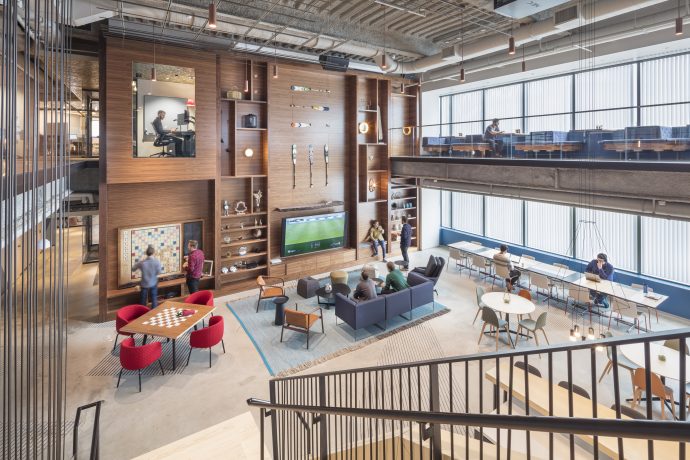
Businesses, big and small, are increasingly turning to shared co-working spaces for short-term and long-term arrangements to fill a real estate gap. While co-working can be a very good solution for many small and growing companies, it may not be a solution for all. Co-working is, indeed a business. It is not the silver bullet to achieving intense innovation, fostering networking, or supporting progressive thinking. That is where a strong office culture and a well-designed workplace lead supreme.
The co-working movement has gained popularity in part due to buzz around startups like WeWork, Industrious, and Convene to name a few. Though seen as the hip, new trend in corporate real estate, fundamentally these spaces miss the aspect of personal design and corporate identity and instead offer generic environments that sell the brands of shared workplace startups instead of a company’s unique character and personality. By choosing these off-the-shelf environments, companies can lose out on opportunities to reinforce brand, mission, and culture with employees and clients, alike. In the short-term, co-working spaces may be a stopgap to meet temporary real estate pain points, but still greater value lies in a long-term investment in physical environments that amplify company mission, values, and culture while meeting unique operational needs and goals. In other words, design your space to meet your individual needs, and the results will better your bottom line.
Brand Is A Company’s Lifeblood
The office spaces of the three most valuable brands in the world—Amazon, Apple, and Google, respectively—have all made international headlines for their unique designs. One can describe the culture of each aforementioned company simply by just looking at their headquarters. Their individual designs go beyond appearances to cater to their particular business and workforce aspirations.
In kind, the most value-creating office designs are carefully articulated to support the particular operations of a given organization—no matter its size or industry. Take, for example, Cambridge Consultants, an innovative product development and technology consulting company that capitalized on office design to better convey who they are and what they do.
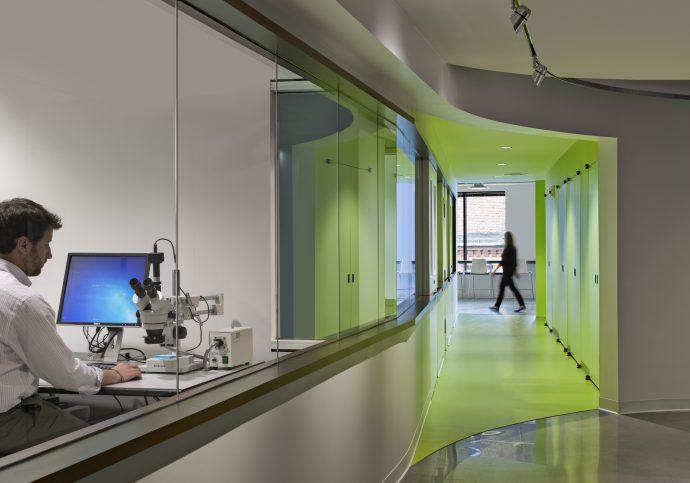
It was not always clear to prospective clients and new hires that the company could take a product from idea to output. A company of both designers and engineers, Cambridge Consultants needed a workplace that reflected the firm’s product development philosophy and showcased their range. Sasaki was charged with designing a Boston headquarters that communicates that their services extend beyond consulting to actually prototyping and delivering products.
The new design showcases engineering and prototyping, externalizing their process of making. The design team brought the labs to the forefront of the space, designed a specific tour loop for visitors, and tied together brand concepts of “hardness” for engineering and the “coolness” for product design to communicate the essence of the business through design. Serge Roux, a senior consultant, now loves taking visitors on tours. Having space manifest the company brand allows visitors to experience brand on a visceral level. Roux explains, “People can instantly see, I’m not here for paperwork, I’m here to make things happen, physically.”
Since moving into their new space in 2014, Cambridge Consultants has achieved an above 90 percent recruitment and retention rate for employees, grown their business two-fold, and expanded into an adjacent floor to accommodate growth. “That’s the kind of return on investment I hoped for,” says Roux. “Now that I’ve watched the office function for us over the last several years, I see the power of design at work every day—not just in our prototypes, but in the very foundation of our space.”
Choice And Variety Drive Productivity
Although a brand represents a business, it is ultimately people who deliver on a brand’s promise and make the engine run. Today, more than ever, people want to run that engine differently.
Business is increasingly conducted away from a formal desk setting. But workplaces weren’t always like this; it wasn’t until technology afforded greater mobility that a whole host of opportunities arose to diversify work settings to improve worker happiness, efficiency, and productivity.
Havas/Arnold Worldwide, a global ad agency that represents major brands like Fidelity, Jack Daniels, and Progressive Insurance, is a highly collaborative group incessantly on the hunt for the next big idea. Their former digs? Almost entirely enclosed, private offices—hardly the environment for effective collaboration.
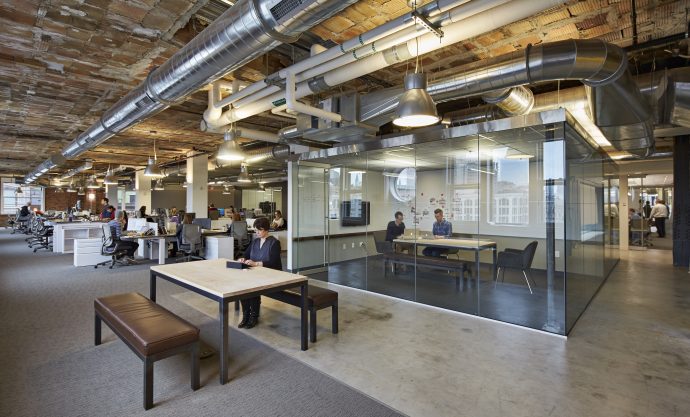
Their business requires many different functions—with their own preferred modes of working—to work together under one roof. Through in-depth analysis of how they work, Sasaki came to understand that as collaborative as Havas/Arnold Worldwide is, many individuals still need space to conduct heads down work. In response, the office design balances the collaborative space with comfortably-scaled neighborhoods of desks so employees do not feel like they are adrift in a sea of open workstations.
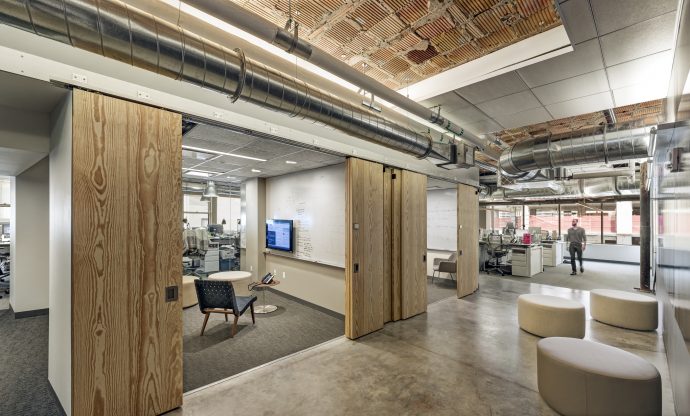
In the new office, leadership and employees sit side by side at light-filled workstations around the perimeter, with access to plenty of alternative work spaces. Employees can engage in organic exchange, whether at the café, two office bars, sky-lit mezzanine, staircase seating areas, or hidden nooks. Every square foot is active and usable—even circulation zones lined with writable surfaces double as alternative meeting spaces. Providing people with choices gives them control over their environment and enables them to do their jobs better.
“The open floor plan has brought down all the walls and all the barriers, and perpetuated greater collaboration” says Pam Hamlin, Global President of Arnold Worldwide, who sees the project as “a catalyst not just for emotional charge and pride, but also for driving business impact.”
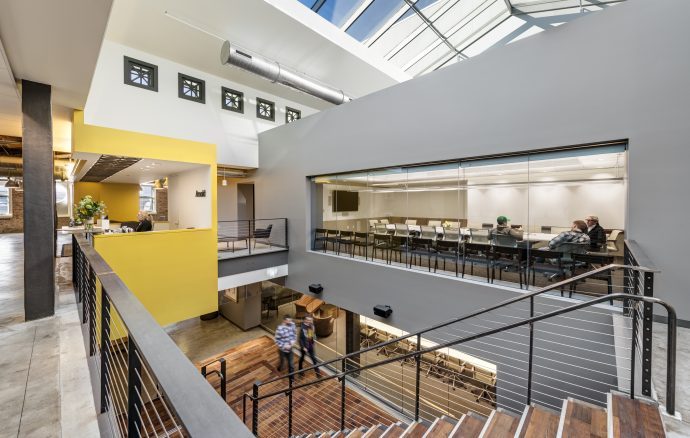
Havas/Arnold Worldwide, condensed their overall real estate to 125,000 sf while improving collaboration. They now have a 2:1 alternative seat to workstation ratio, providing three choices of different work-styles for every person to draw from on a daily basis.
It is a boon for productivity and employee satisfaction. While many generic co-working spaces for rent offer different kinds of spaces for people to choose from, nothing beats the careful analysis of a company’s specific workforce needs to design the right kinds of spaces for people to do their best work.
Structured Spontaneity Leads To Innovation.
Within business there are universal truths. Every workplace must foster ideation and innovation intentionally and continuously to keep their business thriving. Co-working spaces today are pushing networking opportunities—that career-changing encounter, that handshake, that business card exchange—as their most influential asset. But chance-encounters aren’t the lifeblood of innovation. To get people beyond an initial connection point, design for “structured spontaneity,” to yield deliberate and repeated spontaneous moments of collaboration—not only between strangers, but also between co-workers. That is where the iterative work of breakthrough ideation and innovation happens.
Within programming there are also universal truths. Food and beverage draw people together. Adding diverse backgrounds to the mix will always fuel innovation. Adjacencies are a crucial building block to any corporation; bring different departments together around shared collaborative and social space and exchange ensues. But cookie-cutter amenities cannot support a firm’s fundamental strategic advantage. Instead, playing to a firm’s strengths, and more importantly needs, can.
Bringing people together under one roof doesn’t automatically breed collaboration, either. In 2016, OSRAM, the world’s largest developer and producer of lamps and lighting systems, moved their R&D Headquarters for the Americas to 130,000 square feet in Wilmington, MA. Leaving multiple existing sites, the company brought together research and development, sales, administration, and customer operations under a single roof for the first time, to break down barriers. In order to develop innovative synergies and processes, OSRAM’s new workplace needed to holistically support collaboration at every turn.
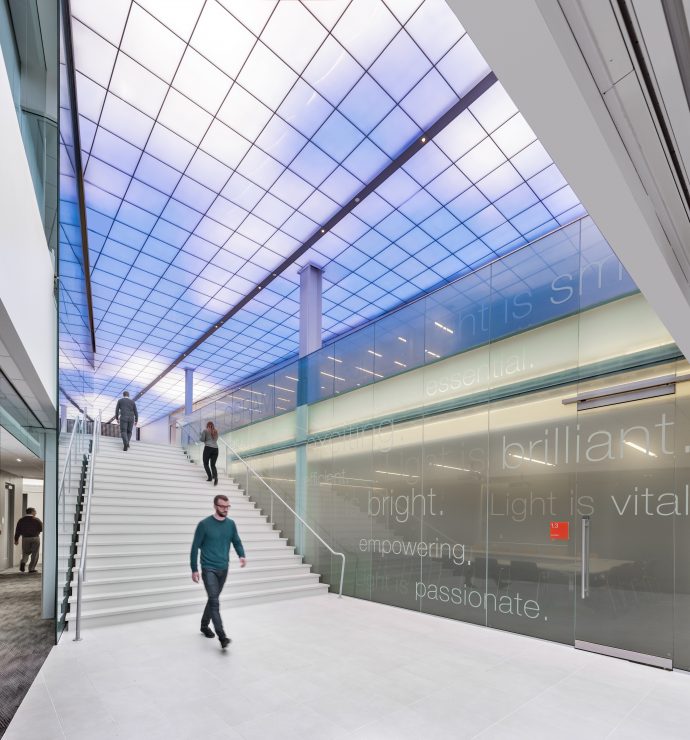
Taking a cue from the company’s mantra, “OSRAM is light,” Sasaki developed a concept that supports interaction, promotes collaboration, and spawns innovation, all based on rays of light. Emanating from the center of the building, these “rays” of program organized all of the shared spaces—from pantries, to conference rooms, to ad-hoc brainstorming spaces—in a manner that portioned the floor-plate into more intimate environments where workers can get independent work done while within close proximity to social areas.

Our design also brought labs to the forefront, putting them on display, just off the lobby. This move introduced a vital transparency that allowed the sales team to better understand products. Likewise, the R&D departments were able to interact with marketing to understand what the customers were looking for and incorporate that feedback into their products—a deliberate co-location that had outsize impact on the growth of the business.
As a result of these office design and programming interventions, OSRAM went from bringing an average of 10 products to market in a single year to launching 250 products in their first year at their new headquarters. They simply needed the space to strike up a conversation with one another to take ideas to the whiteboard, to their labs, and then to market.
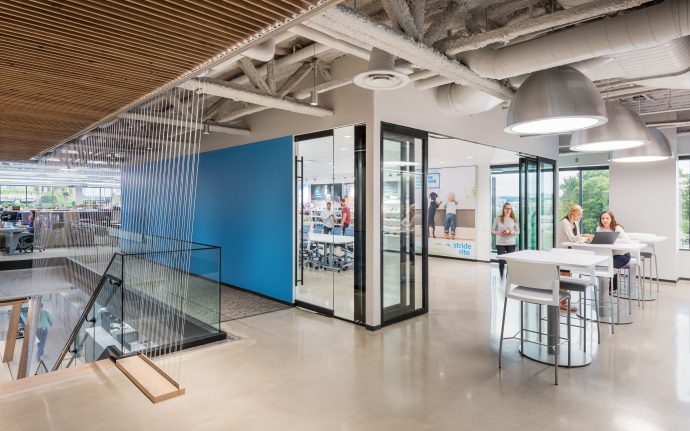
Don’t Get Lost In The Sauce
The trendiness of external co-working spaces in the corporate real estate industry is understandable. It’s true that overarching trends of collaborative open space, artful finishes, ample natural light, and variety of program are generally appealing to workers across the board. WeWork, Industrious, Convene, and others, do capture these trends well, but the application of these trends as a broad-brush solution for every worker and every company can only provide so much return. For companies that prioritize investing in their people, brands, operational efficiency, and client experience more strategically—as every company should—a uniquely designed office that supports exactly who they are and aspire to be is an unparalleled asset that pays off over time. And as more companies try to cut corners on office design, physically well-designed, branded space will become an increasingly impactful differentiator.
There is no silver bullet for solving all the hard real estate decisions, but consider your options and choose thoughtfully. Choose a path that represents the essence of the company, not just the latest trend in the industry. Choose a path that empowers employees to choose how and when they want to work, instead of forcing a workstyle upon them. Choose a path that instills in employees a sense of wonder, exploration, and constant curiosity to keep learning and improving and exceling. And finally, choose a design approach that is going to promote company culture and community, instead of a choosing a company to hitch your brand to.
There is no one-size-fits-all when it comes to workplace design. Good design, by its very definition, is context and identity-specific, solving for issues and concerns tied to each client’s unique challenges and goals. It comes from translating unspoken needs into elegant right-fit designs. It comes from cultivating an authentic sense of place. And that kind of hand-crafted product simply cannot be bought off the shelf.


